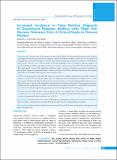Please use this identifier to cite or link to this item:
https://hdl.handle.net/20.500.14356/1444| Title: | Increased Incidence in False Positive Diagnosis of Gestational Diabetes Mellitus with 75gm Oral Glucose Tolerance Test: A Clinical Study in Chinese Women |
| Authors: | K.C., Kamana Zhang, Hua Vaidya, Anju |
| Citation: | K.C.K., ZhangH., & VaidyaA. (2019). Increased Incidence in False Positive Diagnosis of Gestational Diabetes Mellitus with 75gm Oral Glucose Tolerance Test: A Clinical Study in Chinese Women. Journal of Nepal Health Research Council, 17(01), 103-108. https://doi.org/10.33314/jnhrc.v17i01.1588 |
| Issue Date: | 2019 |
| Publisher: | Nepal Health Research Council |
| Article Type: | Original Article |
| Keywords: | Gestational diabetes mellitus International association of the diabetes and pregnancy study groups Oral glucose tolerance test |
| Series/Report no.: | Jan-March, 2019;1588 |
| Abstract: | Abstract Background: Currently, most of the countries across the globe follow the International Association of the Diabetes and Pregnancy Study Groups criteria in the diagnosis of gestational diabetes mellitus, which is based on the analysis of Hyperglycemia and Adverse Pregnancy Outcome study. The International Association of the Diabetes and Pregnancy Study Groups criterion comes with its benefits and doubts. Although it has been adopted worldwide, diagnosis of gestational diabetes mellitus with single test and only one positive value has always been debated and is often criticized. This study aimed to assess if the participant with lesser degree of glucose intolerance increases the incidence of false positive diagnosis of gestational diabetes mellitus with 75gm Oral Glucose Tolerance Test based on International Association of the Diabetes and Pregnancy Study Groups criteria. Methods: This prospective, interventional study was conducted in outpatient department of a tertiary hospital of China over a period of 12 months. 48 patients who were diagnosed with gestational diabetes mellitus in 24-31 weeks of pregnancy by 75mg Oral Glucose Tolerance Test were selected via conventional sampling technique based on lesser degree (less severe, not in need of immediate medical attention) of glucose intolerance. These patients underwent second Oral Glucose Tolerance Test within 2-3 weeks of first test. Patients with normal 2nd Oral Glucose Tolerance Test were observed closely throughout their gestational period and compared with the control group. Results: The mean values of data of control and case group were compared and 37.5% of the patients failed to reproduce the same result with the second test and all of them having normal maternal and fetal outcome without any treatment of gestational diabetes mellitus (t-test, p=0.05). Conclusions: With International Association of the Diabetes and Pregnancy Study criteria, more patients with lesser degree of glucose intolerance have been falsely diagnosed and treated as gestational diabetes mellitus. Keywords: Gestational diabetes mellitus; international association of the diabetes and pregnancy study groups; Oral glucose tolerance test . |
| Description: | Original Article |
| URI: | http://103.69.126.140:8080/handle/20.500.14356/1444 |
| ISSN: | Print ISSN: 1727-5482; Online ISSN: 1999-6217 |
| Appears in Collections: | Vol. 17 No. 1 Issue 42 Jan - Mar 2019 |
Files in This Item:
| File | Description | Size | Format | |
|---|---|---|---|---|
| 1588-Manuscript-9280-2-10-20190430.pdf | Fulltext Download | 323.67 kB | Adobe PDF |  View/Open |
Items in DSpace are protected by copyright, with all rights reserved, unless otherwise indicated.
